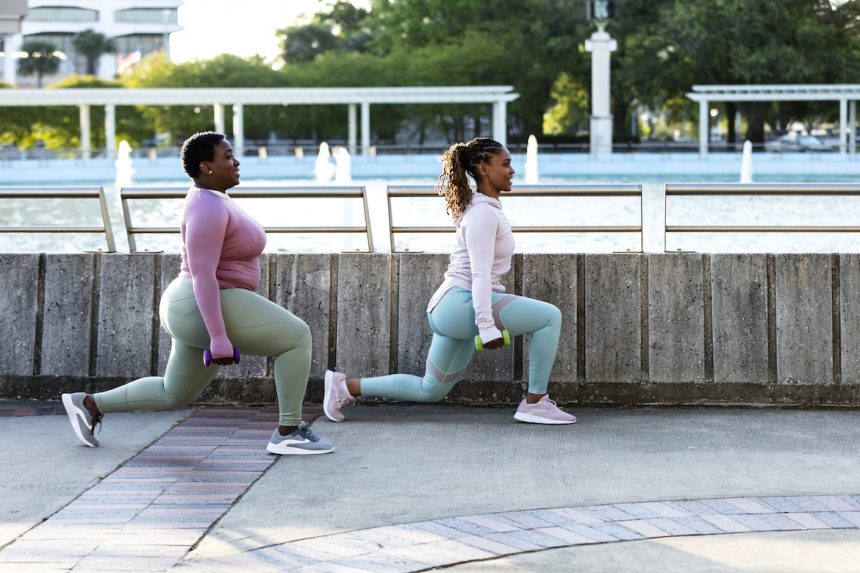If you have a goal to tone and sculpt your legs, squats and lunges may come top of mind for your gym routine. However, it can be tricky to know which to opt for to get the best results—let alone how to do each with the right form. Both squats and lunges are recommended for a well-rounded sculpted lower body,
says certified personal trainer Nico Gonzalez, CPT, global movement trainer and educator for Balanced Body.
Here’s everything you need to know about a lunge vs. squat, how to do each, their pros and cons, and which one you should opt for based on your goals.
Squats
When you think about it, squats aren’t just for sculpted legs (though they can certainly help with that!). They’re an essential part of functioning in everyday life. We squat every day of our lives, so it’s important to keep those muscles and joints working for as long as possible,
Gonzalez says. We all need to squat—whether it be with hand weights, a bar, or just our body weight.
Practicing squats can tone your legs while also improving your overall balance and mobility.
How to do it
Here’s how to properly perform a squat, according to Gonzalez.

- Stand with your feet shoulder-width apart, shoulders back, your toes slightly turned out, and your arms at your side.
- Bend your knees as you push your hips back and shift your weight onto your heels as you squat down.
- Keep your chest up and your core tight.
- Lift your arms straight overhead as you squat down, so your biceps are by your ears.
- Squat down until your knees are parallel to the ground—or stop before that if you have pain or can’t maintain proper form.
- Squeeze your glutes and push through your heels to straighten your legs and return to a standing position.
Work toward a neutral spine, where your back is neither rounded or arched,
Gonzalez says.
If you’re a beginner, you should start with just body weight, but you can add weights to progress over time. The weights should always be light enough that you can maintain proper form. Complete three sets of 15 to 20 reps each, two times per week.
Muscles worked:
Squats are great for sculpted legs, but they also strengthen your core while helping you maintain stability and balance. The squat works the following muscles:
- All three gluteal muscles (gluteus minimus, gluteus medius, and gluteus maximus)
- Quadriceps (knee extensors)
- Hamstrings (knee flexors)
- Erectors (in the back)
- Gastrocnemius (the calves)
- Core muscles (stabilizers)
It may come as a surprise that squats target your core. This exercise is great for activating a number of core muscles—not just your abs.
Pros:
- A squat allows you to use heavier loads as you stand on two legs.
- It also provides more balance and stability than a lunge.
- A natural functional movement, the squat movement mirrors movements you make daily when sitting, getting up from the toilet, and so forth.
- Squats also work several parts of your body at once, called a compound exercise.
Cons:
- It’s important to follow the steps above to properly perform a squat, because they are often done with poor form (mistakes include rounding your back and collapsing your knees inward), which can lead to injury.
- Progressions need additional weight beyond body weight.
- Repetitive squats without a well-rounded workout routine will lead to muscle imbalances.
Lunges
Lunges build lower-body strength and sculpt your legs, both through bodyweight training alone and when you add resistance like weights. They also enhance the balance of the lower body,
Gonzalez says. That balance is challenged through lunges because we use one leg at a time, either in front or behind the body.
Because of that, lunges are a great exercise to improve your overall balance and stability.
How to do it
Here’s how to properly perform a lunge, according to Gonzalez.

- Start standing with your feet hip-width apart, arms folded in front of your chest.
- Step your left leg forward, bending both your front and back legs to a 90 degree angle.
- Keeping your chest tall, bend both knees and drop toward the floor with control.
- Keep lowering until your back knee is about an inch off the ground (or as low as you can comfortably go).
- Push through your left foot to bring yourself back to the starting position.
If balance is a challenge, begin with assistance before progressing to no assistance. Start with body weight, but eventually add weights for progression. Complete three sets of 15 to 20 reps each, two times per week.
Muscles worked:
The muscles worked in a lunge are similar to those worked in a squat, including the core.
- Glutes
- Quadriceps
- Hamstring muscles
- Gastrocnemius
- Core muscles
Pros:
- Lunges allow you to strengthen both sides of your body individually, helping to decrease imbalances.
- If you want to gain strength while also training other qualities like balance, coordination, and stability, lunges are a good option.
- Lunges are a functional exercise that improves daily activities like walking, running, hiking, and climbing stairs.
Cons:
- Lunges may be challenging for balance, particularly at first.
- People with certain underlying conditions or injuries may need to avoid lunges.
The bottom line
Both squats and lunges can help you tone your legs. If you want sculpted legs, I recommend using both to reap the most benefits,
Washington says.
Ultimately, the choice between a lunge and a squat will depend on your specific goals and needs in terms of balance, strength, and stability.





